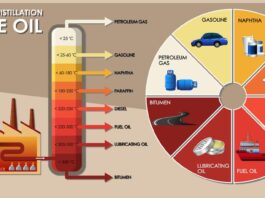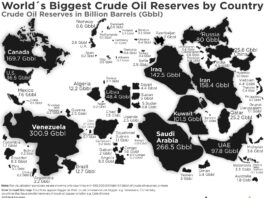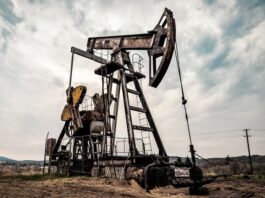Petroleum geology is the study of rock formations and the occurrence of petroleum within them. It is a crucial aspect of the exploration, appraisal, and development of oil and gas reserves. This field encompasses the understanding of how petroleum is formed, where it is found, and how it can be extracted and produced. With the increasing demand for energy and the continued reliance on oil and gas, petroleum geology has become increasingly important. In this article, we will explore the fundamentals of petroleum geology and the role it plays in the petroleum industry. From the origin of petroleum to the production geology, we will delve into the various aspects of this fascinating field and understand why it is essential to the energy sector. So, buckle up and let’s embark on this exciting journey through the world of petroleum geology.

Contents
The origin of petroleum
The origin of petroleum is a fascinating topic that has been the subject of scientific inquiry for many years. Petroleum is formed from organic matter that has been subjected to high pressure and heat over millions of years. The process of petroleum formation starts with the accumulation of dead plants and animals on the ocean floor. Over time, this organic material is buried by sediment, subjected to high pressure and heat, and transformed into petroleum.
The exact conditions that are required for petroleum formation are still not fully understood, but it is believed that the right combination of temperature, pressure, and the presence of certain microorganisms is necessary. The source rock, or the rock formation that contains the organic material, must also be present. Common source rocks include shale, limestone, and sandstone.
Once the petroleum is formed, it migrates from the source rock into nearby rock formations. If these rock formations are porous and permeable, the petroleum can accumulate and form a reservoir. The reservoir rock must also have a trap, such as an anticline or fault, that prevents the petroleum from escaping to the surface. This trap allows the petroleum to accumulate and be preserved, making it accessible for extraction.
In summary, the origin of petroleum is a complex process that involves the accumulation of organic material, high pressure and heat, the presence of source and reservoir rocks, and the presence of a trap. Understanding the origin of petroleum is important for petroleum geologists as they search for new oil and gas reserves and work to extract petroleum from existing reservoirs.
Petroleum traps mechanism
Petroleum traps are geological structures that prevent petroleum from escaping to the surface and allow it to accumulate and be preserved in a reservoir. The trap mechanism is a key factor in the formation of a petroleum reservoir and plays a crucial role in the exploration and development of oil and gas fields.
There are several types of trap mechanisms, including:
- Structural traps: These traps are created by the deformation of rock formations due to tectonic activity. Anticlines, faults, and dome-like structures are common examples of structural traps.
- Stratigraphic traps: These traps occur when a layer of permeable rock is overlain by an impermeable layer, preventing the petroleum from escaping. Examples of stratigraphic traps include pinchouts, shale seals, and mudstones.
- Combined traps: Some petroleum reservoirs are formed by a combination of structural and stratigraphic traps. For example, an anticline that is capped by an impermeable layer is considered a combined trap.
It is important to note that the presence of a trap mechanism does not guarantee the presence of petroleum. A reservoir rock that contains petroleum must also be present for a petroleum trap to form. The quality and quantity of the petroleum in a trap are dependent on several factors, including the source rock, the porosity and permeability of the reservoir rock, and the fluid pressure within the reservoir.
In conclusion, petroleum traps are a critical component of the petroleum reservoir and play a crucial role in the exploration and development of oil and gas fields. Understanding the various types of traps and their mechanisms is essential for petroleum geologists as they search for new petroleum reserves and work to extract petroleum from existing reservoirs.

Exploration techniques
Exploration techniques are essential tools used by petroleum geologists to find and assess petroleum reserves. The goal of exploration is to locate and evaluate the size, quality, and recoverability of petroleum reserves. There are several techniques used in petroleum exploration, including:
- Seismic surveys: Seismic surveys are used to create a subsurface image of the rocks and fluids beneath the earth’s surface. This is done by transmitting sound waves into the subsurface and measuring the time it takes for the waves to return to the surface. The data collected from seismic surveys is used to create subsurface maps that can help identify potential petroleum reservoirs.
- Drilling: Drilling is the process of penetrating the subsurface to obtain rock samples and fluid data. This data is used to assess the size, quality, and fluid content of the reservoir. Exploration wells are drilled to determine the presence of petroleum, while appraisal wells are drilled to assess the size and quality of the reservoir.
- Well logging: Well logging is the process of measuring various physical and chemical properties of the rocks and fluids within a wellbore. This data is used to determine the presence of petroleum, the type of rock formations, and the fluid content of the reservoir.
- Remote sensing: Remote sensing is the use of satellite and aerial imagery to gather information about the earth’s surface. This data is used to identify surface features that may indicate the presence of petroleum, such as oil seeps or anomalous vegetation.
- Geological and geochemical analysis: Geological and geochemical analysis is the study of rock samples and fluid data to determine the presence and quality of petroleum. This information is used to assess the potential of the reservoir and determine the best course of action for exploration and development.
In conclusion, exploration techniques are essential tools used by petroleum geologists to find and assess petroleum reserves. The combination of these techniques provides a comprehensive picture of the subsurface and helps to identify the best opportunities for petroleum exploration and development.
Reservoir rocks
Reservoir rocks are an essential component of a petroleum reservoir and play a crucial role in the exploration and development of oil and gas fields. A reservoir rock is defined as a permeable and porous rock that contains petroleum. The quality and quantity of the petroleum in a reservoir are dependent on several factors, including the porosity and permeability of the reservoir rock, the fluid pressure within the reservoir, and the presence of a trap mechanism that prevents the petroleum from escaping to the surface.
Common reservoir rocks include sandstones, carbonates, and conglomerates. Sandstones are made up of sand-sized grains of minerals and are typically composed of quartz, feldspar, and rock fragments. Carbonates are rocks that are composed mainly of calcium carbonate and are often formed from the accumulation of shells and other organic material. Conglomerates are rocks that are composed of large, rounded particles, and are often formed from the accumulation of gravel and boulders.
The porosity of a reservoir rock refers to the amount of void space within the rock, and is an important factor in determining the amount of petroleum that can be stored. High porosity rocks have large void spaces, which can store more petroleum. The permeability of a reservoir rock refers to the ease with which fluids can flow through the rock, and is also an important factor in determining the amount of petroleum that can be recovered. High permeability rocks allow for easy fluid flow and make it easier to extract petroleum.
In conclusion, reservoir rocks play a crucial role in the exploration and development of oil and gas fields. Understanding the properties of reservoir rocks, such as porosity and permeability, is essential for petroleum geologists as they assess the potential of petroleum reservoirs and determine the best course of action for exploration and development.
Production geology
Production geology is the study of petroleum reservoirs during the production stage. The goal of production geology is to optimize the extraction of petroleum and maximize the recovery of oil and gas. This involves the continuous monitoring of the reservoir and the wellbore, as well as the management of the production process.
Production geologists use a variety of techniques to monitor the petroleum reservoir and optimize production. These techniques include:
- Reservoir modeling: Reservoir modeling is the process of creating a numerical model of the petroleum reservoir to simulate the flow of fluids within the reservoir. This helps production geologists to understand the behavior of the reservoir and predict future production.
- Well logging: Well logging is the process of measuring various physical and chemical properties of the rocks and fluids within a wellbore. This data is used by production geologists to monitor changes in the reservoir and assess the effectiveness of the production process.
- Reservoir monitoring: Reservoir monitoring involves the continuous measurement of fluid pressure, temperature, and other properties within the reservoir to assess the performance of the well and the behavior of the reservoir.
- Enhanced oil recovery (EOR) techniques: Enhanced oil recovery techniques are methods used to increase the amount of petroleum that can be recovered from a reservoir. This can include techniques such as waterflooding, gas injection, and chemical flooding.
- Production optimization: Production optimization involves the continuous adjustment of the production process to maximize the recovery of petroleum and minimize the costs associated with production.
In conclusion, production geology is an important aspect of petroleum exploration and production. The goal of production geology is to optimize the extraction of petroleum and maximize the recovery of oil and gas. This is achieved through the continuous monitoring of the reservoir and the wellbore, as well as the use of various techniques and technologies to improve the performance of the production process.
Enhanced oil recovery techniques
Enhanced oil recovery (EOR) techniques are methods used to increase the amount of petroleum that can be recovered from a reservoir. The primary goal of EOR techniques is to optimize the recovery of petroleum and maximize the economic benefits of oil and gas production.
There are several types of EOR techniques, including:
- Waterflooding: Waterflooding is a method of EOR in which water is injected into the reservoir to displace trapped oil and increase the pressure within the reservoir. This helps to increase the flow of oil to the wellbore, making it easier to extract.
- Gas injection: Gas injection is a method of EOR in which gases such as carbon dioxide or natural gas are injected into the reservoir to displace trapped oil and increase the pressure within the reservoir. This helps to increase the flow of oil to the wellbore, making it easier to extract.
- Chemical flooding: Chemical flooding is a method of EOR in which chemicals are added to the injected fluid to improve the displacement of oil. This can include the use of surfactants, polymers, and other chemicals to alter the properties of the injected fluid and improve its ability to displace oil.
- Thermal recovery: Thermal recovery is a method of EOR in which heat is applied to the reservoir to increase the viscosity of the oil and make it easier to extract. This can include the use of steam injection or in-situ combustion.
- Microbial enhanced oil recovery (MEOR): MEOR is a method of EOR in which microorganisms are used to improve the recovery of petroleum. This can include the use of bacteria to degrade oil or produce surfactants to alter the properties of the oil and make it easier to extract.
In conclusion, EOR techniques are methods used to increase the amount of petroleum that can be recovered from a reservoir. The goal of EOR is to optimize the recovery of petroleum and maximize the economic benefits of oil and gas production. There are several types of EOR techniques, including waterflooding, gas injection, chemical flooding, thermal recovery, and microbial enhanced oil recovery.
Major topics in petroleum geology
Petroleum geology is a broad and interdisciplinary field that encompasses several subdisciplines. Some of the major subdisciplines in petroleum geology include:
- Basin analysis: Basin analysis is the study of the geological and tectonic processes that have shaped sedimentary basins and their subsurface structures. Basin analysis helps to understand the distribution of petroleum and other minerals within a sedimentary basin.
- Source rock analysis: Source rock analysis is the study of the rocks and sediments that contain organic material that can be converted into petroleum. This involves the characterization of the source rock, the assessment of its maturity, and the prediction of the quality and quantity of petroleum that can be generated from it.
- Reservoir geology: Reservoir geology is the study of the rocks and fluids within a petroleum reservoir. This includes the characterization of the reservoir, the assessment of its productivity, and the prediction of its performance over time.
- Petroleum geochemistry: Petroleum geochemistry is the study of the chemical composition of petroleum and its relationship with the source rock and the reservoir. This includes the analysis of the isotopic composition of petroleum, the assessment of its quality and maturity, and the prediction of its migration and accumulation history.
- Petroleum engineering: Petroleum engineering is the application of engineering principles to the exploration, production, and transportation of petroleum. This includes the design and construction of wells, the management of the production process, and the optimization of the recovery of petroleum.
- Seismic exploration: Seismic exploration is the use of seismic waves to image the subsurface structures and identify the potential locations of petroleum reservoirs. This involves the acquisition of seismic data, the processing and interpretation of the data, and the integration of the seismic data with other geological and geophysical data.
In conclusion, petroleum geology is a broad and interdisciplinary field that encompasses several subdisciplines. Some of the major subdisciplines in petroleum geology include basin analysis, source rock analysis, reservoir geology, petroleum geochemistry, petroleum engineering, and seismic exploration.
References
- Petroleum Geology: North-West Europe and Global Perspectives—Volume 1, edited by Peter R. Dickson and J. Alan Parker
- Reservoir Geology, edited by John W. Harbaugh and Richard C. Surdam
- Petroleum Geoscience: From Sedimentary Environments to Rock Physics, edited by Trond H. Torsvik and Athanasios S. Kornprobst
- Petroleum Geology of the South Caspian Basin, edited by B. A. Nurushev and M. K. R. B. Rais
- Petroleum Geology: An Introduction, by Richard C. Selley, L. Robin M. Cocks, and Ian R. Palmer
- Introduction to Petroleum Exploration for Non-Geologists, by William J. Dewey
- The American Association of Petroleum Geologists (AAPG) website (www.aapg.org)
- The Society of Petroleum Engineers (SPE) website (www.spe.org)




